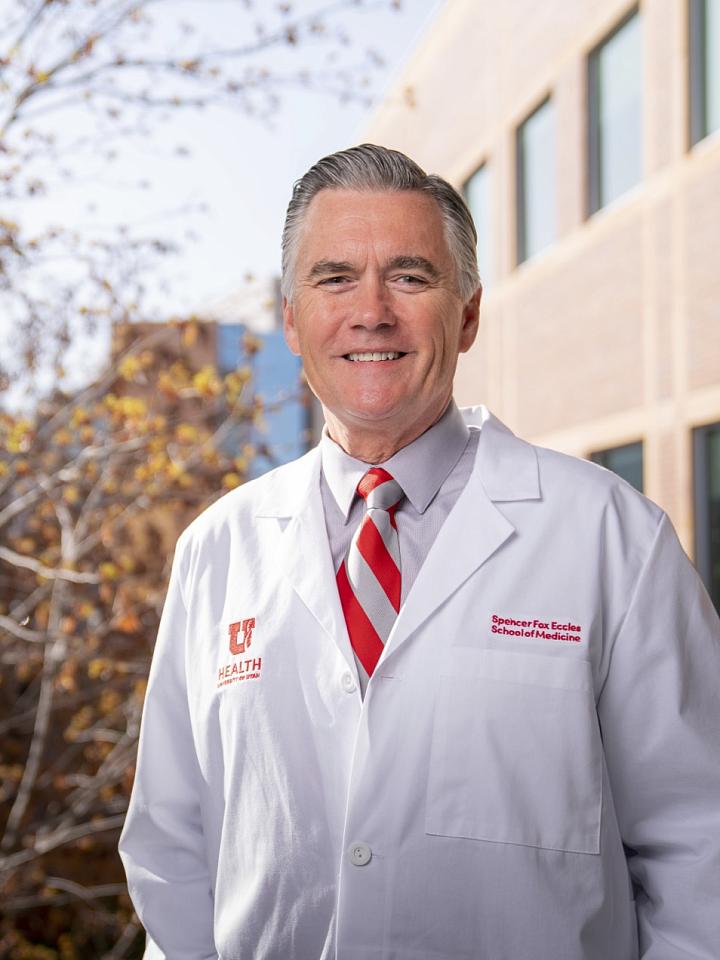SALT LAKE CITY— Michael L. Good, M.D., CEO of University of Utah Health and Senior Vice President for Health Sciences, and David W. Grainger, Ph.D., Distinguished Professor of Biomedical Engineering and of Molecular Pharmaceutics and Chair of the Department of Biomedical Engineering, have been named Fellows of the National Academy of Inventors (NAI), the organization announced on December 12, 2023. Their selection brings the number of NAI Fellows from the U to 21.
“Being elected to the NAI is a kind of capstone,” Good says. “It’s gratifying to know that my early work has been recognized by peers as innovative and worthy of this distinction.”
Of his own election to NAI, Grainger, who is also the Ole and Marty Jensen Endowed Chair, says, “Together with my teaching and mentoring the next generation of student creators, thinkers, and inventors, translating technology to practical utility and adoption is highly rewarding."

Election as an Academy Fellow is the highest professional distinction awarded solely to inventors. The 2023 Class of Fellows is comprised of 162 distinguished academic inventors.
Michael L. Good, M.D.: Simulation to save lives
Good’s invention, the Human Patient Simulator, was originally inspired by a trip to the batting cages. It was 1985, and as an anesthesiologist, he was frustrated that residents in his field could only practice their skills during the few times of day when surgeries were scheduled. As he swung at ball after ball, he reasoned that if a pitching machine could give athletes the ability to practice outside of a baseball game, perhaps he could create a simulator that enabled anesthesiologists to practice outside the operating suite.
That “a-ha” moment inspired Good to lead an intensive research and development program at University of Florida that resulted in 10 patents. The interdisciplinary effort combined Good’s expertise in computer science and medicine with that of dozens of collaborators specializing in math, engineering, and business. In 1993, the lifelike mannequins that simulate both routine and rare medical scenarios—from hypoventilation to tension pneumothorax—entered the market, with medical educators from the U being early adopters.

Today, next-generation patient simulators are empowering health care professionals across the globe to refine multiple lifesaving skills. The innovation has saved countless lives.
Good credits his experience as inventor, researcher, and interdisciplinary team leader as helping shape his leadership style today. U of U Health has flourished since his arrival in 2018. With an annual budget of $5.3 billion in FY22, the academic medical center encompasses five hospitals and 12 community clinics, a 1,700-member University of Utah Medical Group, a world-class research enterprise with $521.5M in sponsored projects annually, a 253,000-member health plan, and numerous institutes and centers spanning more than 200 specialties.
“I think people come to academic medicine and academic health sciences because they want to make the world a better place,” Good says. “My goal is to create an environment at University of Utah Health that supports the creativity and wisdom that sparks innovation.”
David Grainger, Ph.D.: Medical device vanguard
A recognized expert in biomaterials chemistry and medical device innovation, Grainger’s research has contributed to applications in diverse fields, including drug delivery, medical implants, diagnostic devices, and new cell therapies. His seven patents to date have been translated into multiple commercial products, from multiplexed medical diagnostic components to tendon repair implants to antimicrobial medical devices. Beyond health care applications, Grainger’s patented surface chemistries have also been used as protective coatings in inkjet printers.
University of Utah spin-off company, Elute, uses Grainger’s technology in its unique implantable devices to combat infections after joint replacement surgeries. Every surface of a prosthetic joint is susceptible to colonization by bacteria, leading to increased risk of implant-centered infection. Elute’s synthetic, bone-like degradable bone filler “granules” are engineered to encourage new bone in-growth and release antibiotics at controlled rates as they degrade, enhancing implant bone healing and reducing implant bacterial colonization. Elute’s first-in-human-approved antimicrobial combination device is now in Phase I pivotal clinical trials.

“Engineering’s intersection with medicine is an exciting place to work and teach, with many challenges seeking creative solutions. University of Utah fosters relationships, research, and collaborations at this intersection. I’m so pleased to pursue work that makes a real impact on people’s health and quality of life.”
“Engineering’s intersection with medicine is an exciting place to work and teach, with many challenges seeking creative solutions,” Grainger says. “University of Utah fosters relationships, research, and collaborations at this intersection. I’m so pleased to pursue work that makes a real impact on people’s health and quality of life.”
In addition to the National Academy of Inventors, Grainger is a Fellow of the American Association for the Advancement of Science (AAAS), the Society for Biomaterials, the International Union of the Societies of Biomaterials Science and Engineering, and the American Institute for Medical and Biological Engineering.
In good company
Since its inception in 2012, the NAI Fellows program has grown to include 1,898 exceptional researchers and innovators who hold more than 63,000 U.S. patents and 13,000 licensed technologies. NAI Fellows are known for the societal and economic impact of their inventions, contributing to major advancements in science and consumer technologies. Their innovations have generated more than $3 trillion in revenue and generated 1 million jobs.
The 2023 class of Fellows will be honored and presented with their medals at the NAI 13th Annual Meeting on June 18th, 2024, in Raleigh, North Carolina.
The complete list of NAI Fellows is available here.
